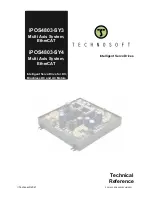
MSG11-5715-743/EN: AC20F Series - Hardware Installation Manual
MSG11-5715-743/EN 24.04.2023
117 (148)
1. Clean Earth Busbar (insulated from the mounting panel):
-
Used as a reference point for all signal and control cabling.
-
It may be further subdivided into an analog and a digital reference busbar, each separately
connected to the star earthing point.
-
The digital reference is also used for any 24 V control.
-
Control / Signal, Encoder, Analogue Input and Communication cables require screening,
with the screen connected at the inverter end
only
.
However, if high frequency noise is a problem, earth the screen at the non-inverter end via
a 0.1
F capacitor, and move the screen connect at the inverter end from the control board
terminals to the protective earth point.
2. Dirty Earth Busbar (insulated from the mounting panel):
-
Used for all power earths, i.e., protective earth connections.
-
It is also used as a reference for any 110 or 220 V control used, and for the control
transformer screen.
3. Metal Work Earth Busbar:
-
The control cubicle mounting panel is used as this earth busbar and should provide
earthing points for all parts of the cubicle including panels and doors.
-
This busbar is also used for power screened cables that terminate near to (
≈10 cm), or
directly into an inverter, such as Motor cables, Dynamic Brake Resistor cables (and
resistors themselves), or connections between inverters.
-
Use U-clips to clamp the screened cables to the back panel to ensure optimum HF
connection.
4. Signal / Control Screen Earth Busbar (insulated from the mounting panel):
-
Used for signal/control screened cables which do not go directly to the inverter.
-
Place this busbar as close as possible to the point of cable entry.
-
‘U’ clamp the screened cables to the busbar to ensure an optimum HF connection.
Flexible, large cross-section cable or braids should be used to ensure low HF impedance.
Bus bars should be arranged so that the connections to the single earth point is as short as possible.
















































